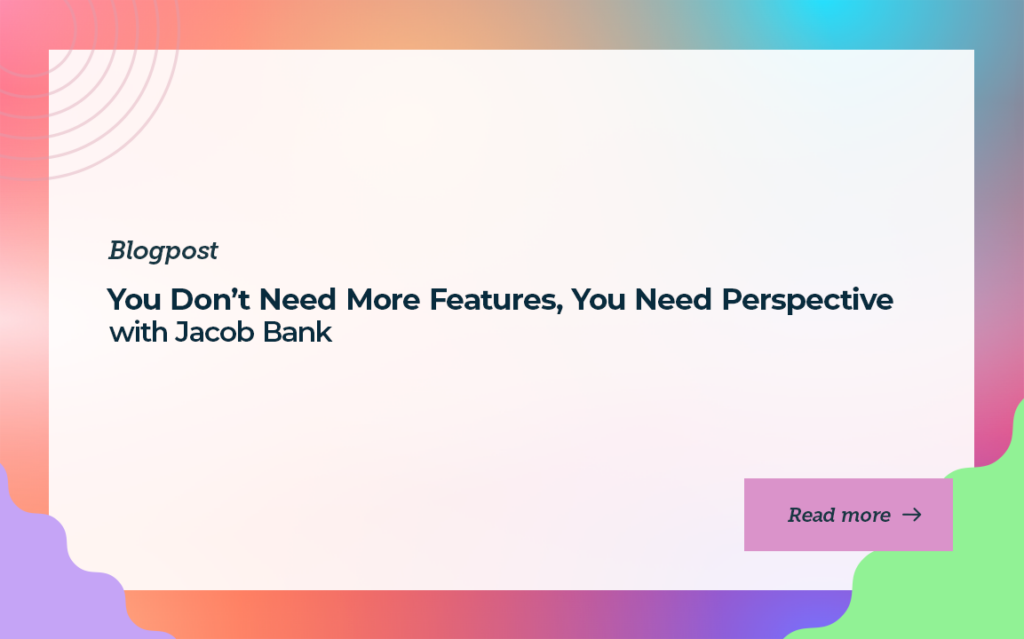You Don’t Need More Features, You Need Perspective with Jacob Bank

When we first spoke to Jacob Bank, founder of Relay, the product was ambitious, powerful, horizontal, flexible, but a bit challenging to grasp. It was early, and the clarity wasn’t quite there.
Fast forward a year, and something’s changed. Jacob’s post caught fire on LinkedIn: customer love, sharp metrics, and unmistakable momentum. It was clear that we had to bring him back on the podcast.
The Challenge of Building a Horizontal Product
Relay is an AI agent and workflow-building platform. It’s horizontal, meaning it can serve everyone from a cupcake bakery to a Fortune 500 sales team. And that’s a blessing and a curse.
Why horizontal is hard:
- Positioning hell: When your product can do everything, it’s hard to explain what it actually does, or who it’s for.
- No obvious channel: You can’t just target HR leaders or RevOps managers with cold emails. You need to create your own go-to-market path.
- One tool, many expectations: Relay had to serve users with wildly different needs, tech stacks, and technical skill levels.
Phase 1: Stand on the Shoulders of Giants
To find focus, Relay leaned on a smart play: anchor to a well-known category leader.
“We positioned ourselves as the modern alternative to Zapier.”
This wasn’t new: Linear did it to Jira, Attio to Salesforce, and Loops to Mailchimp. Relay followed suit: a clean, fast, AI-native alternative for teams who care more about user experience than enterprise checkboxes.
It worked. They got their first 100 paying customers. Retention ticked up. User love started to show. For the first time, Jacob says, “It felt like a real business.”
Phase 2: Turning on the AI Jets
The Zapier comparison got them on the map. But something was missing.
Despite solid growth and retention, new user signups had flatlined. Relay needed a tailwind, and what better tailwind than AI?
So they relaunched with a new identity: the AI-first automation platform.
Instead of positioning on UX alone, they went all-in on powerful, easy-to-set-up AI steps: enriching leads, summarizing calls, drafting posts. The shift paid off.
- Retention and engagement rose again.
- User love deepened.
- The product matured into something customers wanted to stick with.
However, while existing users remained and expanded, new sign-ups had not yet shown the same increase. The product was sticky, but not yet viral. The next challenge? Cracking top-of-funnel growth.
Phase 3: Messaging That Hits, and the Channel That Changed Everything
The next breakthrough didn’t come from a product change. It went from a positioning epiphany.
At the end of 2024, Jacob wrote a 25-page internal doc. The thesis? Relay was solving the right problems, but discussing them incorrectly.
“No one cares about ‘no-code automation.’ It sounds nerdy and hard. But everyone wants an AI agent that does work for them.”
The word agent had gone mainstream. It wasn’t a term reserved for technical circles anymore. It now stood for something people wanted. Jacob proposed a simple shift: stop pitching Relay as automation software and start presenting it as the easiest way to build AI agents that work for you.
He tested the theory the next day. One LinkedIn post. One GIF.
The post walked through a simple use case: an AI agent that looks up LinkedIn profiles based on spreadsheet data. It was short. It was visual. It was useful.
It blew up.
- 600,000 impressions.
- 7,000 likes.
- 5,000 comments.
And it wasn’t a fluke. Jacob had never broken 10,000 impressions before. Clearly, the message had hit a nerve.
A Tagline Change That Moved the Funnel
Encouraged by the response, they swapped the headline on Relay’s homepage: From “The new standard in no-code automation” → to “Create AI agents that work for you.”
Result? Landing page conversions jumped from ~7% to ~10%. That’s a massive lift from one line of copy.
“That tagline change was worth more than any product feature we shipped that month.”
But the real magic came next.
The Network Effect of AI Agent Demos
People don’t post about automations. They do post about AI agents.
This simple psychological shift sparked the channel Relay had been missing. Founders and operators began sharing what they built with Relay on LinkedIn. The use cases were practical and impressive, and most importantly, shareable.
Jacob’s following exploded from 4,000 to over 47,000 in a few months. Impressions scaled to hundreds of thousands per week. Comments poured in. And the flywheel turned:
- More posts → more impressions
- More impressions → more signups.
- More signups → more shared agents.
- More shared agents → more posts.
The missing energy unlocked. Suddenly, Relay wasn’t just sticky, it was spreading.
Lessons in Messaging, Content, and Conversion
The magic wasn’t just in the messaging or the product. It was in Jacob’s relentless experimentation.
Despite being new to marketing, he forced himself to figure it out. “I always felt like we had a great product,” he said, “but I wasn’t doing it justice.”
The shift from reactive tinkering to consistent traction came from doing what great founders do: testing quickly, learning even faster, and doubling down when it pays off.
Education Is the New Growth Engine
Once the “I built an AI agent to do X” post format started to saturate, Jacob didn’t chase diminishing returns. He pivoted again. This time, toward education.
He posted a simple webinar invite: “Want to learn how to build an AI agent from scratch? Join me live.” No fancy design. Just a one-slide Google poster.
It hit 700,000 impressions and 6,000 comments.
People weren’t just curious about AI agents. They were hungry to learn how to use them. Education had become the hook.
Now, Relay hosts weekly live sessions, consistently drawing hundreds of attendees. The content shifted from novelty to enablement, and it worked.
Anchoring in Use Cases That Resonate
When engagement cooled again, Jacob spotted another opportunity. A viral post featured a hypothetical organizational chart of AI agents, but it didn’t feel realistic. So he countered:
“Here are the 40 AI agents I actually use for marketing. They’re real, and they’re live.”
That post exploded: 1.5 million impressions, 16,000 comments, possibly the most comments ever on a LinkedIn post.
The takeaway: Build content around real, specific use cases. Not what AI agents could do, but what they are doing today, in the hands of people like your target customer.
Moving from Hits to Habits
The biggest shift wasn’t viral posts, it was the structural shift toward reliability:
- Jacob’s following gave them base awareness. Now, a “low-performing” post with 10,000 views still attracts over 200 ideal prospects.
- More importantly, other users began sharing their own AI agent builds. Relay’s distribution was no longer bottlenecked to Jacob alone.
That’s when things got durable.
“It no longer feels brittle. Even if a post flops, the right people still see us, and others are sharing, too.”
What’s Next: Closing the Activation Gap
Relay has a solid foundation, characterized by high retention, a strong top-of-funnel presence, and a loyal and vocal user base. But Jacob sees the next inflection clearly:
There’s still too much friction between “Relay looks cool” and “I have a live agent running that creates value for me.”
Unlock that, and it’s game on again.
Scale Simplicity, Teach Relentlessly, and Deliver Leverage
Relay isn’t chasing complexity. Quite the opposite. The path forward is about relentless simplification, making it dead-simple for anyone, not just technical users, to build and benefit from AI agents.
The mission? Serve the person who just discovered ChatGPT and wonders: “Could this do work for me… even while I sleep?”
That means three big priorities:
- Intuitive UX: If a user stumbles, the product still isn’t simple enough. Jacob makes 6–7 customer calls daily to identify and resolve friction. It’s working, but they’re far from done.
- Massive Inspiration Library: 70 templates today. The vision? Thousands. Built by the team and the community, helping users see what’s possible, fast.
- Practical Education: Weekly live sessions. YouTube walkthroughs. A philosophy: learning AI agents isn’t optional, it’s the new Excel.
“Creating AI agents will be a foundational skill for the next 40 years, just like Excel was for the last 40.”
AI Agents as ROI Machines
Relay users aren’t just automating, they’re unlocking hours of leverage at cents-on-the-dollar cost:
- A recruiting firm used Relay to write client-candidate match docs. What took 30 minutes now costs $1.30 and gets done in seconds.
- A content team receives personalized, weekly LinkedIn trend reports, generated for $0.40 instead of a $5,000 monthly agency retainer.
- One founder filtered 25,000 companies using a high-end AI model. Cost? $12. Value? Days of SDR work, instantly recaptured.
“$12 and $4 are both $0, compared to the value these agents create.”
The economics of AI agents are absurdly asymmetric. Time saved, quality retained, scale unlocked. And Relay is the wedge making that accessible to everyone.
From Button-Clicking to Delegation
Relay’s next act isn’t just about product features. It’s about reshaping how users interact with software itself.
The goal? No UX. Just delegation.
Users shouldn’t have to click 37 times to configure a workflow. They should be able to say what they want done and let an agent handle it. That’s the vision: not a better UI, but no UI at all.
“The next UX is no UX. The interface isn’t the app, it’s the outcome.”
Currently, building workflows, even with the aid of AI, remains too manual. Too brittle. Too dependent on technical fluency. Jacob’s team is working on solving this from the ground up:
- Let users explain what they want, not how to do it.
- Guide them to express their intent clearly enough for AI to execute.
- Build agents that iterate, learn, and perform, just like a contractor would.
This isn’t theoretical. It’s already happening.
Relay’s users are generating client-candidate match docs, dynamic SEO reports, sales playbooks, and ICP filters that save hours, all for a few dollars (or cents). Not just speed. Not just cost. Leverage.
AI Agents vs. Everything Else
Forget the jargon wars. What’s a chatbot? A co-pilot? An agent?
Jacob puts it plainly:
- Chatbot: Something you talk to. (e.g., ChatGPT)
- Co-pilot: Something that sits beside you in another tool. (e.g., Notion AI)
- Agent: Something that works for you, behind the scenes. No prompts. No tabs. Just results.
That’s the mental model that sticks: “It works while I sleep.” And it’s why AI agents are more than a trend, they’re the beginning of a productivity refactor.
“Creating AI agents will be like learning Excel. If you don’t get fluent, you’ll fall behind.”
The Leverage Layer
We’re entering an era where the interface disappears, and the only thing that matters is what gets done on your behalf. The agent becomes your intern, your ops hire, your assistant, your analyst.
And just like working with people, the challenge is clear communication.
- What do I want done?
- What does success look like?
- What inputs do I need to provide?
Relay isn’t trying to be the flashiest tool. It’s trying to be the most useful one, for real users, solving real problems, in ways they can actually implement.
If this plays out the way it’s shaping up, the future won’t be defined by which CRM or automation tool you use, it’ll be by what agents you’ve built on top of them.
Conclusion
This story isn’t just about Relay, it’s a blueprint for any founder navigating early traction.
The biggest unlock wasn’t a feature. It was clear: Don’t just build tools. Build outcomes.
As AI evolves, the winners won’t be the ones who ship the most buttons. They’ll be the ones who let users say, “Here’s what I need, just make it happen.”
If you’re building right now, ask yourself:
- Are you simplifying complexity or merely relocating it?
- Are you chasing features or creating leverage?
- Are you helping people work, or helping them delegate?
The next wave of great companies won’t just be used. They’ll be trusted to work while we sleep.
Check what you can do with Relay.app and follow Jacob Bank on LinkedIn to never miss an update.
And don’t forget to contact us to learn what Predictable Revenue can do for you!
NO TIME TO READ?


